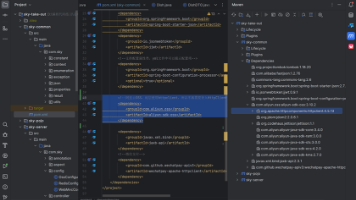C语言循环链表全解析
恭喜你!现在你已经了解了循环链表的基本概念和操作。记住:循环链表的最后一个节点指向第一个节点,形成环状结构遍历循环链表时需要特别注意终止条件,避免无限循环循环链表在处理周期性任务时非常有用一定要注意指针操作和内存管理,避免内存泄漏学习数据结构就像搭积木,掌握了基础结构后,你就能构建更复杂的程序。循环链表是你编程工具箱中的一个重要工具,多多练习,你会越来越熟练!如果有任何问题,欢迎在评论区留言,我会
今天我们来学习C语言中一个有趣的数据结构——循环链表。如果你已经了解了单向链表,那么循环链表对你来说会很容易理解!
想象一下游乐场的旋转木马:每匹马都连接着前面的马,最后一匹马又连接着第一匹马,形成一个循环。循环链表就是这样的数据结构!
为什么要学习循环链表?
-
它解决了单向链表不能循环访问的问题
-
在许多实际应用中有独特优势(如游戏开发、轮询调度)
-
帮助你更深入理解链表和指针的概念
第一部分:循环链表的基本结构
循环链表分为两种:单向循环链表和双向循环链表。我们先从简单的单向循环链表开始:
c
#include <stdio.h>
#include <stdlib.h>
// 定义循环链表节点
struct Node {
int data; // 存储数据
struct Node* next; // 指向下一个节点的指针
};新手注意事项:
-
循环链表和普通链表的节点结构是一样的
-
区别在于循环链表的最后一个节点指向第一个节点,形成环状
-
循环链表没有真正的"尾节点",因为它是循环的
第二部分:创建循环链表
让我们一步步创建循环链表:
c
// 创建新节点
struct Node* createNode(int data) {
// 申请内存空间
struct Node* newNode = (struct Node*)malloc(sizeof(struct Node));
// 检查内存是否申请成功
if (newNode == NULL) {
printf("内存分配失败!\n");
exit(1); // 退出程序
}
// 初始化节点
newNode->data = data;
newNode->next = NULL;
return newNode;
}
// 创建循环链表并添加节点
void createCircularList(struct Node** head, int values[], int n) {
if (n == 0) {
*head = NULL;
return;
}
// 创建第一个节点
*head = createNode(values[0]);
struct Node* current = *head;
// 添加剩余节点
for (int i = 1; i < n; i++) {
current->next = createNode(values[i]);
current = current->next;
}
// 将最后一个节点指向头节点,形成循环
current->next = *head;
}第三部分:循环链表的基本操作
1. 遍历循环链表
c
// 打印循环链表
void printCircularList(struct Node* head) {
if (head == NULL) {
printf("链表为空!\n");
return;
}
struct Node* current = head;
printf("循环链表: ");
do {
printf("%d ", current->data);
current = current->next;
} while (current != head); // 当再次遇到头节点时停止
printf("\n");
}2. 在循环链表中插入节点
c
// 在循环链表的指定位置插入节点
void insertNode(struct Node** head, int position, int data) {
struct Node* newNode = createNode(data);
// 如果链表为空
if (*head == NULL) {
*head = newNode;
newNode->next = newNode; // 指向自己形成循环
return;
}
struct Node* current = *head;
// 如果要在头部插入
if (position == 0) {
// 找到尾节点
while (current->next != *head) {
current = current->next;
}
// 插入新节点
newNode->next = *head;
current->next = newNode;
*head = newNode;
return;
}
// 找到要插入位置的前一个节点
for (int i = 0; i < position - 1; i++) {
current = current->next;
// 如果已经循环一圈,说明位置超出范围
if (current == *head) {
printf("位置超出范围!\n");
free(newNode);
return;
}
}
// 插入新节点
newNode->next = current->next;
current->next = newNode;
}3. 从循环链表中删除节点
c
// 从循环链表中删除指定位置的节点
void deleteNode(struct Node** head, int position) {
if (*head == NULL) {
printf("链表为空!\n");
return;
}
struct Node* current = *head;
struct Node* prev = NULL;
// 如果要删除头节点
if (position == 0) {
// 如果只有一个节点
if (current->next == *head) {
free(current);
*head = NULL;
return;
}
// 找到尾节点
while (current->next != *head) {
current = current->next;
}
// 删除头节点
current->next = (*head)->next;
free(*head);
*head = current->next;
return;
}
// 找到要删除的节点和前一个节点
for (int i = 0; i < position; i++) {
prev = current;
current = current->next;
// 如果已经循环一圈,说明位置超出范围
if (current == *head) {
printf("位置超出范围!\n");
return;
}
}
// 删除节点
prev->next = current->next;
free(current);
}第四部分:完整的示例程序
让我们写一个完整的程序来测试循环链表:
c
#include <stdio.h>
#include <stdlib.h>
// 节点定义
struct Node {
int data;
struct Node* next;
};
// 函数声明
struct Node* createNode(int data);
void createCircularList(struct Node** head, int values[], int n);
void printCircularList(struct Node* head);
void insertNode(struct Node** head, int position, int data);
void deleteNode(struct Node** head, int position);
void freeCircularList(struct Node* head);
int main() {
struct Node* head = NULL;
int values[] = {10, 20, 30, 40, 50};
int n = sizeof(values) / sizeof(values[0]);
printf("创建循环链表...\n");
createCircularList(&head, values, n);
printCircularList(head);
printf("\n在位置2插入值25...\n");
insertNode(&head, 2, 25);
printCircularList(head);
printf("\n在头部插入值5...\n");
insertNode(&head, 0, 5);
printCircularList(head);
printf("\n删除位置3的节点...\n");
deleteNode(&head, 3);
printCircularList(head);
printf("\n删除头节点...\n");
deleteNode(&head, 0);
printCircularList(head);
// 释放内存
freeCircularList(head);
return 0;
}
// 创建新节点
struct Node* createNode(int data) {
struct Node* newNode = (struct Node*)malloc(sizeof(struct Node));
if (newNode == NULL) {
printf("内存分配失败!\n");
exit(1);
}
newNode->data = data;
newNode->next = NULL;
return newNode;
}
// 创建循环链表
void createCircularList(struct Node** head, int values[], int n) {
if (n == 0) {
*head = NULL;
return;
}
*head = createNode(values[0]);
struct Node* current = *head;
for (int i = 1; i < n; i++) {
current->next = createNode(values[i]);
current = current->next;
}
current->next = *head;
}
// 打印循环链表
void printCircularList(struct Node* head) {
if (head == NULL) {
printf("链表为空!\n");
return;
}
struct Node* current = head;
printf("循环链表: ");
do {
printf("%d ", current->data);
current = current->next;
} while (current != head);
printf("\n");
}
// 插入节点
void insertNode(struct Node** head, int position, int data) {
struct Node* newNode = createNode(data);
if (*head == NULL) {
*head = newNode;
newNode->next = newNode;
return;
}
struct Node* current = *head;
if (position == 0) {
while (current->next != *head) {
current = current->next;
}
newNode->next = *head;
current->next = newNode;
*head = newNode;
return;
}
for (int i = 0; i < position - 1; i++) {
current = current->next;
if (current == *head) {
printf("位置超出范围!\n");
free(newNode);
return;
}
}
newNode->next = current->next;
current->next = newNode;
}
// 删除节点
void deleteNode(struct Node** head, int position) {
if (*head == NULL) {
printf("链表为空!\n");
return;
}
struct Node* current = *head;
struct Node* prev = NULL;
if (position == 0) {
if (current->next == *head) {
free(current);
*head = NULL;
return;
}
while (current->next != *head) {
current = current->next;
}
current->next = (*head)->next;
free(*head);
*head = current->next;
return;
}
for (int i = 0; i < position; i++) {
prev = current;
current = current->next;
if (current == *head) {
printf("位置超出范围!\n");
return;
}
}
prev->next = current->next;
free(current);
}
// 释放循环链表内存
void freeCircularList(struct Node* head) {
if (head == NULL) {
return;
}
struct Node* current = head;
struct Node* next;
// 先断开循环,变成普通链表
while (current->next != head) {
next = current->next;
free(current);
current = next;
}
// 释放最后一个节点
free(current);
printf("内存已释放!\n");
}运行结果:
text
创建循环链表...
循环链表: 10 20 30 40 50
在位置2插入值25...
循环链表: 10 20 25 30 40 50
在头部插入值5...
循环链表: 5 10 20 25 30 40 50
删除位置3的节点...
循环链表: 5 10 20 30 40 50
删除头节点...
循环链表: 10 20 30 40 50
内存已释放!第五部分:循环链表的应用场景
1. 约瑟夫问题(Josephus Problem)
这是一个经典的问题:N个人围成一圈,从第一个人开始报数,报到M的人出列,然后从下一个人重新开始报数,直到所有人出列。
c
// 解决约瑟夫问题
void josephusProblem(int n, int m) {
// 创建循环链表,编号从1到n
struct Node* head = NULL;
for (int i = n; i >= 1; i--) {
struct Node* newNode = createNode(i);
if (head == NULL) {
head = newNode;
newNode->next = newNode;
} else {
newNode->next = head->next;
head->next = newNode;
}
}
struct Node* current = head;
struct Node* prev = NULL;
printf("约瑟夫问题(n=%d, m=%d)的出列顺序: ", n, m);
while (current->next != current) { // 直到只剩一个节点
// 数m-1个人
for (int i = 0; i < m - 1; i++) {
prev = current;
current = current->next;
}
// 删除当前节点(报数到m的人)
prev->next = current->next;
printf("%d ", current->data);
free(current);
current = prev->next;
}
printf("%d\n", current->data);
free(current);
}2. 轮询调度(Round Robin Scheduling)
在操作系统中,循环链表可以用于实现轮询调度算法,让每个进程都有平等的机会使用CPU。
c
// 简单的轮询调度模拟
void roundRobinScheduling(int processes[], int n, int timeQuantum) {
// 创建进程队列(循环链表)
struct Node* head = NULL;
for (int i = n - 1; i >= 0; i--) {
struct Node* newNode = createNode(processes[i]);
if (head == NULL) {
head = newNode;
newNode->next = newNode;
} else {
newNode->next = head->next;
head->next = newNode;
}
}
printf("轮询调度(时间片=%d):\n", timeQuantum);
struct Node* current = head;
while (current != NULL) {
printf("进程%d运行%d时间片\n", current->data, timeQuantum);
// 模拟进程执行
// ...
// 移动到下一个进程
current = current->next;
// 如果回到起点,说明所有进程都执行了一轮
if (current == head) {
printf("--- 一轮结束 ---\n");
// 这里可以添加终止条件,比如所有进程都完成
break;
}
}
// 释放内存
freeCircularList(head);
}第六部分:常见错误和解决方法
错误1:无限循环
c
// 错误:遍历循环链表时使用错误的终止条件
void printListWrong(struct Node* head) {
struct Node* current = head;
while (current != NULL) { // 错误!循环链表没有NULL结尾
printf("%d ", current->data);
current = current->next;
}
// 这将导致无限循环!
}
// 正确:使用do-while循环
void printListCorrect(struct Node* head) {
if (head == NULL) return;
struct Node* current = head;
do {
printf("%d ", current->data);
current = current->next;
} while (current != head); // 当再次遇到头节点时停止
}错误2:内存泄漏
c
// 错误:没有正确释放循环链表
void freeListWrong(struct Node* head) {
struct Node* current = head;
while (current != NULL) { // 错误!循环链表没有NULL结尾
struct Node* next = current->next;
free(current);
current = next;
}
// 这将导致无限循环和内存泄漏!
}
// 正确:先断开循环再释放
void freeListCorrect(struct Node* head) {
if (head == NULL) return;
// 先找到尾节点并断开循环
struct Node* current = head;
while (current->next != head) {
current = current->next;
}
current->next = NULL;
// 然后像普通链表一样释放
current = head;
while (current != NULL) {
struct Node* next = current->next;
free(current);
current = next;
}
}总结
恭喜你!现在你已经了解了循环链表的基本概念和操作。记住:
-
循环链表的最后一个节点指向第一个节点,形成环状结构
-
遍历循环链表时需要特别注意终止条件,避免无限循环
-
循环链表在处理周期性任务时非常有用
-
一定要注意指针操作和内存管理,避免内存泄漏
学习数据结构就像搭积木,掌握了基础结构后,你就能构建更复杂的程序。循环链表是你编程工具箱中的一个重要工具,多多练习,你会越来越熟练!
如果有任何问题,欢迎在评论区留言,我会尽力解答!
更多推荐
 已为社区贡献1条内容
已为社区贡献1条内容








所有评论(0)